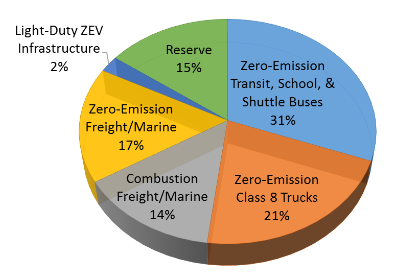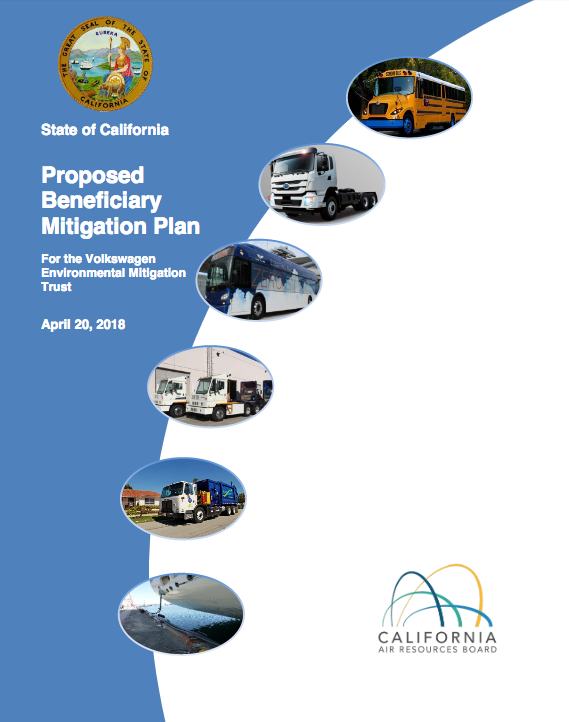Note: GJEL Accident Attorneys regularly sponsors coverage on Streetsblog San Francisco and Streetsblog California. Unless noted in the story, GJEL Accident Attorneys is not consulted for the content or editorial direction of the sponsored content.
The National VW Environmental Trust, funded by fees paid by Volkswagen after it was found to have created software to cheat air pollution regulations, has $423 million for California to spend on cleaning up harm caused by VW's fraud.
The California Air Resources Board's (CARB) mitigation plan, approved last week pending final approval by the fund trustee, includes major investments in zero-emission replacements for heavy duty trucks and buses, as well as at freight facilities and ports. It will also be used to create a network of charging stations for light-duty vehicles.
CARB staff estimates that the plan will, over the next ten years, “mitigate” the estimated 10,000 tons of NOx that the illegal VW engines produced in California. The plan will also accelerate the zero-emission transformation of California's heavy-duty vehicles, which is necessary to meet the state’s goals on clean air, climate change, zero-emission vehicles, and fossil fuel use reduction.
The plan will support and expand existing programs, such as the Carl Moyer program--which allocates money to local air districts for clean engines--and the state's Low Carbon Transportation Investments.
Some stakeholders, notably the Diesel Technology Forum, have objected that CARB's plan doesn't spend enough on short-term fixes. They argue that “clean diesel” or so-called “near zero” emission technologies could produce more immediate emission reductions than the more expensive, longer-term replacements with zero-emission vehicles and equipment that CARB's plan is aimed at.
The plan discusses the trade-offs of the two approaches, as well as the trade-offs between concerns about local emission sources and statewide goals.
“One of CARB’s challenges is finding the right balance between investing in technologies that provide cost-effective, near-term emission benefits, versus investing in transformative zero-emission technologies that cost more in the near-term but are necessary to meet our longer-term 2030 and 2050 goals discussed later in this Plan. We need both," says the plan.
CARB ultimately decided to spend more on zero-emission categories to jump-start the adoption of these technologies, which are in a relatively early—and expensive-- stage of development but in the end will reduce emissions far more than fossil fuel technologies can. From CARB's plan:
This [investment in zero-emission technologies] is necessary and appropriate in order to fund enough vehicles to move the market and have a real impact in accelerating zero-emission technologies towards broader commercialization.
The plan is also in keeping with a set of guiding principles CARB staff crafted with public input:
- Fund actions that offset the VW NOx impacts while reducing risk to sensitive populations and ensuring disadvantaged or low-income community benefits
- Align with state priorities
- Focus on zero-emission technologies where available and on lowering NOx emissions everywhere else
- Prioritize expenditures that are surplus to regulatory requirements and complementary and additional to other public investments
- Provide investments statewide to transform the heavy-duty sector
- Use a known method of implementation, including public process, project management, and competitive solicitations where appropriate
- Ensure accountability and transparency
CARB's press release quotes CARB Chair Mary D. Nichols as saying: “This is a landmark moment in the saga of Volkswagen’s environmental violations. Over the next ten years this plan will put in place not only tools to clean up VW’s excess emissions, but also to help achieve further reductions of smog-forming pollution for decades to come.”
The plan will provide:
- $130 million for zero-emission transit, school, and shuttle buses
- $90 million for zero-emission heavy duty freight and drayage trucks
- $70 million for zero-emission airport and marine ground support equipment such as forklifts and cargo-handling equipment and shore power systems that allow ships to turn off engines while in port
- $60 million to replace diesel freight trucks and ships
- $10 million for light duty vehicle infrastructure
... and will keep $63 million in reserve.







